Nestled in the slopes of Mount Hor, Petra is an ancient city, carved out of the very mountains in which it resides. Dubbed the Rose-Red City for the color of the surrounding sand stone rocks, Petra was initially built in the 6th century BC as a capital city for the Nabataean people. They created a sophisticated water control system and artificial oasis to fuel this impressive desert metropolis. The city remained independent for several centuries, protected naturally by the surrounding rock formations. But even the Nabateans fell to Roman forces in 106 AD after their water was allegedly poisoned.
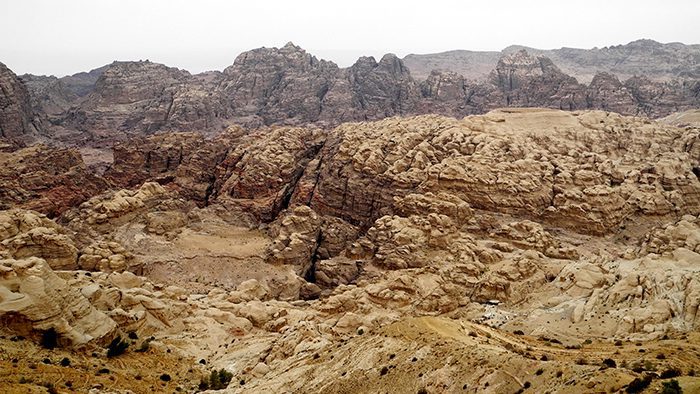
Lingering marks of this occupation can still be seen today, with Roman ruins and a Byzantine church mixed in with the remnants of Petra. An earthquake in 363 AD crippled Petra’s buildings and the water system, leaving much of the city in ruins. The incredible rock constructions remained hidden for centuries until a Swiss explorer discovered it in 1812. Since then, it has become Jordan’s most visited attraction and was designated a World Heritage Site in 1985.
Check out 5 Things to Do in Aqaba
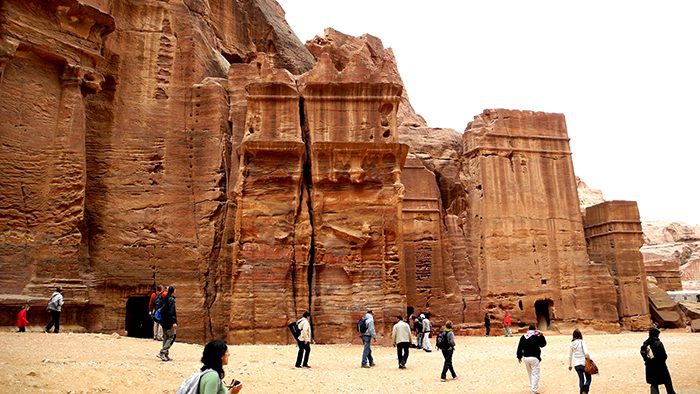
The park has been featured in several movies, including Indiana Jones and the Last Crusade, Transformers: Revenge of the Fallen, Arabian Nights, and Mortal Kombat: Annihilation. It has also been featured in several video games, including Lego Indiana Jones, and has been referenced in several novels.
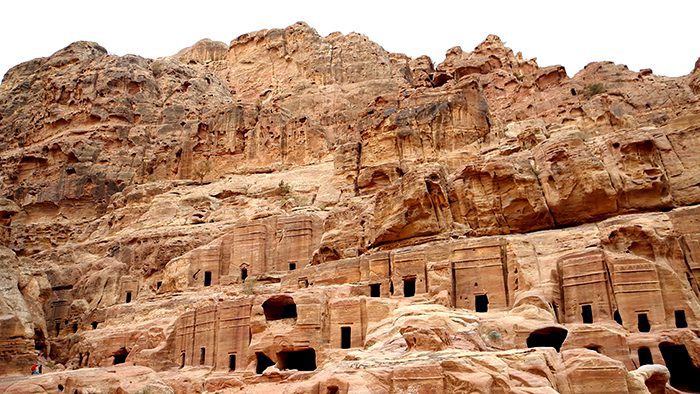
The iconic film Lawrence of Arabia also found its origins in the history of Petra. In 1917, T. E. Lawrence led a small force of Arabian and Syrian soldiers to Petra in order to aid the British invasion of North Africa by distracting the Turkish army.
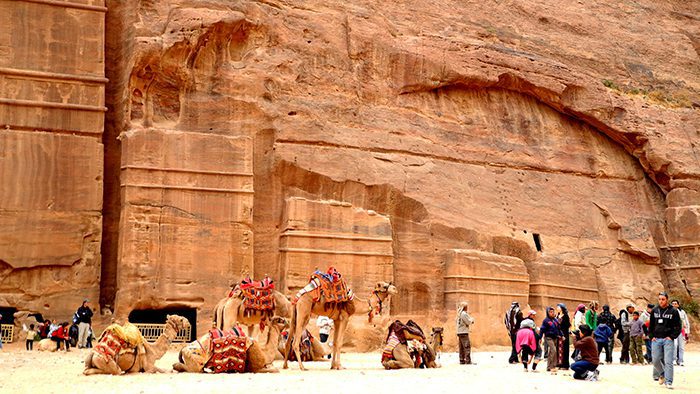
Petra is a magical archaeological site that attracts visitors from all over the world. I recommend that you research and hire a reputable tour guide before arriving in Petra. A good guide will make all the difference when you are walking among the caves and structures within Petra and he or she can meet you at the ticket office. Entry into Petra is pricey and costs 50 JD per person. Getting to Petra early is key! The heat can get brutal so try to get there as soon as Petra opens to avoid busy crowds and the scorching sun. 8 a.m. is the perfect arrival time if you plan to explore most of it in one day.
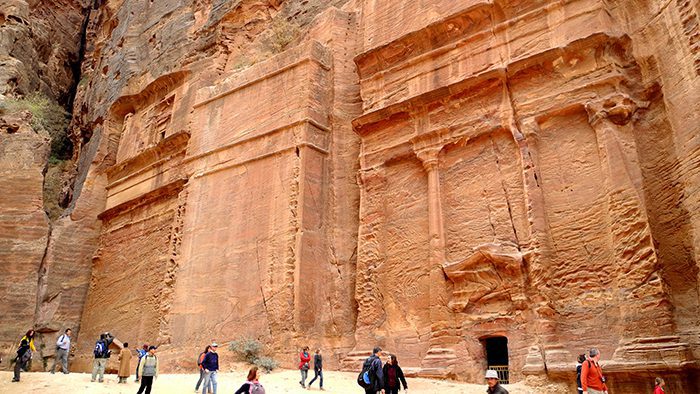
In addition to booking early, bring cash in JD for tipping — that is if you plan to take a camel or donkey ride anywhere in Petra, or buy any souvenirs. The local Bedouin operate everything in the park except for the restaurants, and they prefer to be paid in cash. A small tip will suffice (1 or 2 JD), but it is not obligatory. Bring comfortable walking shoes that you would not mind getting full of dust. A hat or visor would also be a good idea to protect you from the sun. Here are the 15 things to see in Petra.

Ad-Deir is easily one of Petra’s most famous attractions, second only to Al Khazneh (Treasury). Leading up to the monastery is a flight of 800 steps that cut directly through the rock. It can take 45 minutes to one hour to reach it. The scenery along the way is simply breathtaking, and you have the option of renting a donkey for the climb. The monastery is vast in size (about 50 yards tall) and incredibly elegant. Ad-Deir’s design is reminiscent of Al Khazneh, but some of the embellishments have been simplified. Overall, the architectural design is a great example of Nabatean classical style.
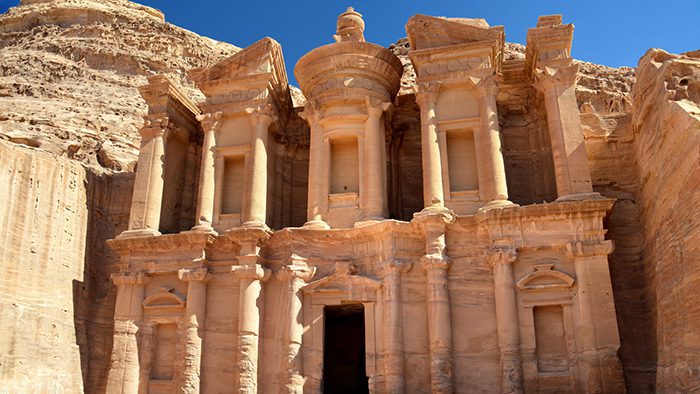
The monastery used to serve as an important stop for pilgrimage processions and the open terrace in the front was used to accommodate large gatherings of people. During the Byzantine Era, the monastery is believed to have been used as a church as you can find remnants of inscribed crosses on some interior walls.

As-Siq, Arabic for shaft, is a 1,300-yard long gorge that serves at the stunning main entrance into Petra. “Siq” for short, the gorge is straddled by the remains of a gigantic arch that collapsed during an earthquake in 1896. But the most stunning aspect of the walk into Petra is the natural beauty of the multicolor sandstone rocks themselves and the innovation of the people of Petra.

The gorge is filled with multihued rocks and puzzling geological formations. As you walk through, tall cliffs that seem to graze the sky surround you. The rocks themselves have been carved to create terraces for farming and channels for water. Votive niches in the rock indicate that the gorge was sacred to the Nabataean people. It is simply impossible to not be awestruck by the beauty of the As-Siq gorge.
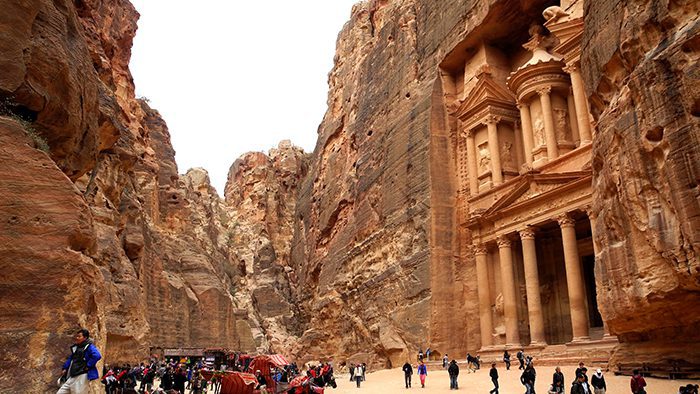
When you emerge from As-Siq, you are immediately confronted with the dazzling immensity of Al-Khazneh, or the Treasury. This is easily the most beautiful and best-preserved monument in Petra. With a unique mix of Hellenistic and Nabataean architecture, it was intended as the tomb of a prominent Nabataean king but scholars believe it was later used as a temple.
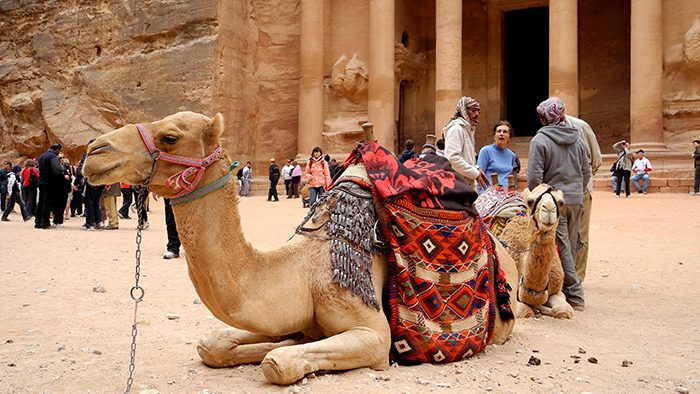
Careful observers will notice bullet holes in the upper urn. Bedouin tribes regularly fired at the urn in an attempt to break it, believing it to be hollow and filled with treasures. As the day wears on, the Treasury’s decorative face changes color. In the morning, Al-Khazneh is often described as having a rich peach tint, which darkens to rose in the afternoon and is blood red by sunset. Getting your picture taken atop a camel in front of Al-Khazneh will complete your visit to one of earth’s manmade wonders.
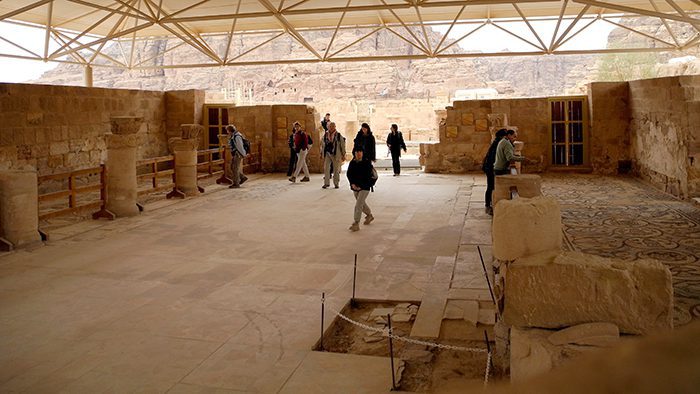
Interestingly, the Byzantine church was most likely built in the 5th or 6th century, after the earthquake that led to the decline of many of Petra’s freestanding structures. The church was remodeled twice in the following years until a fire and several earthquakes caused it to be abandoned. The materials used to build the church are believed to have come from other ruined monuments.

In 1993, more than 150 papyrus scrolls were discovered inside the church, the largest find of its kind in Jordan. The writing on the scrolls is deteriorated, due to the fire in the 7th century but if deciphered, they could provide a glimpse into Petran society during its later years. The church also houses some spectacular mosaics and highly decorated pavement designs.

This is a beautiful colonnaded street that winds its way through the city. On each side are temples, public buildings and shops. A nymphaeum, a monument dedicated to nymphs, once graced the street but all that remains is a marble pavement.
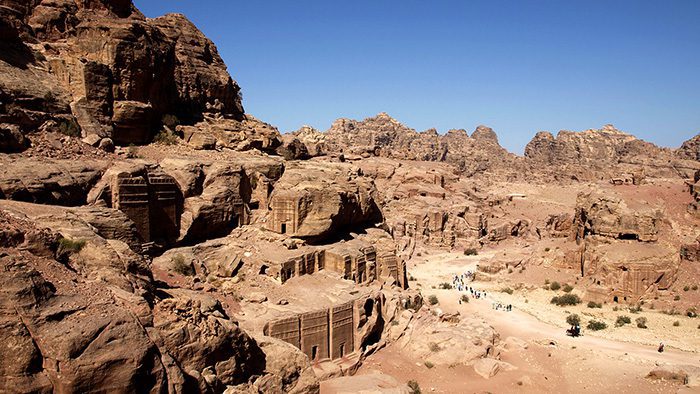
The only way to access this area is to take a long hike up a flight of steps carved into the mountain. But at the top, visitors are rewarded with a spectacular view of Petra in an especially well-preserved area. This spot was most likely used for religious ceremonies to honor the gods and for performing funeral rites for the dead.

On the road into Petra, visitors will begin to notice tombs carved into the surrounding rock, the most famous of which is the Obelisk Tomb. This tomb showcases a unique mix of Egyptian and Greco-Roman architecture. The obelisk itself is clearly Egyptian in origin, while the niches between the obelisks are Greco-Roman. The upper floor contains the actual tomb and lower floor was used as dining hall for funeral rites. This formal dining room, referred to in Roman as a triclinium, contains three benches that were used during the yearly celebrations and feasts to honor the dead.

This magnificent tomb greatly resembles a palace, with its multiple levels and ornately decorated columns and pillars. Despite being badly eroded, it is still a sight to behold.

Visiting Petra at night offers a completely different experience. Upon arriving to the stoned city, visitors will find the walkway softly lit by candles. Follow the path to arrive at the Treasury, where hundreds of candles glow alongside a group of Bedouins. Sit down, accept their herb tea offering, and enjoy the traditional sounds of Bedouin folklore music. Petra by night offers a unique glimpse into the lifestyle of this rugged, but gentle culture. Be sure to arrive early as seating is limited and the music can last upwards of two hours. Evenings in the desert can be chilly, so be sure to bring a sweater or jacket.
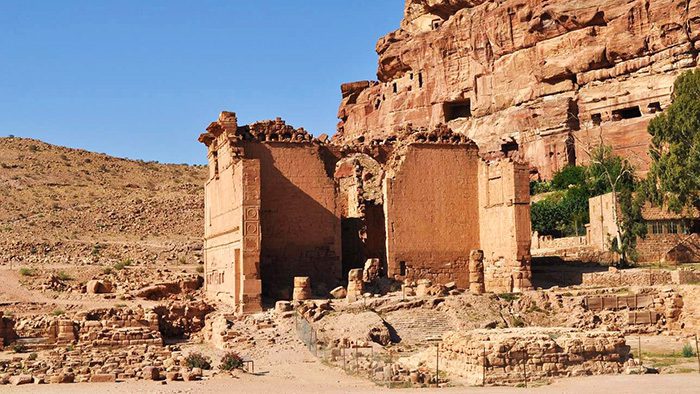
Qasr al-Bint is the only freestanding building left in Petra, having withstood centuries of earthquakes and floods. This 76-foot structure is thought to have served as the main temple in this ancient Nabataean capital. The temple and the altar inside were reserved exclusively for priests making public sacrifices, but commoners were allowed onto the paved precinct. Archaeologists have confirmed that the outer walls of Qasr al-Bint were once stuccoed in bright colors and its friezes were adorned with carvings of the busts of gods.
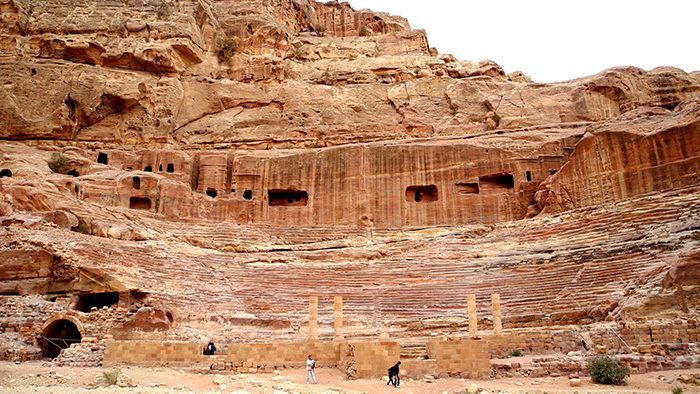
The Roman Theater is located on the Street of Faces, named for the rows of intricate tombs that line its sides. Despite the Roman architecture, the Nabataeans built it in the 1st century AD, when Roman influence had seeped into the Middle East. It is for the most part carved into the rock, except for a front portion that is free standing. It was originally built to house 3,000 people but was later expanded to house 7,000 people. Recently, a marble statue of Hercules was discovered in the rooms beneath the stage and was relocated to a museum.

The Royal Tombs in Petra used to rival the beauty of Al-Khzneh, but time and erosion have worn away much of their grandeur. Across the Wadi, they were originally built to house the bodies of Nabataean dignitaries. The unmistakable Urn Tomb is the largest tomb, with a recessed façade and a two-tiered vault below that is believed to have been a prison once. It was originally built for the Nabatean King Malichus II in the 1st century AD but was converted to a church some 400 years later. A Greek inscription on one of the walls describes the conversion process.

The Palace Tomb, also known as the Tomb in Two Stories, was named as such due to its overall resemblance to a royal palace. To complete this tomb, workers had to attach preassembled stones to the upper left hand corner. The Tomb of Sextus Florentinus belonged to a Roman governor who grew so enamored with Petra that he asked his sons to bury him there. In essence, the Royal Tombs were altered throughout the years, but served a similar purpose for various civilizations that inhabited Petra.

This is the only tomb in Petra with an identifiable occupant. A Latin inscription over the doorway indicates that the tomb belonged to Roman governor Sextius Florentinus, who oversaw the province of Arabia. His dying wish was to be buried in Petra and his tomb was carved around 130 AD.
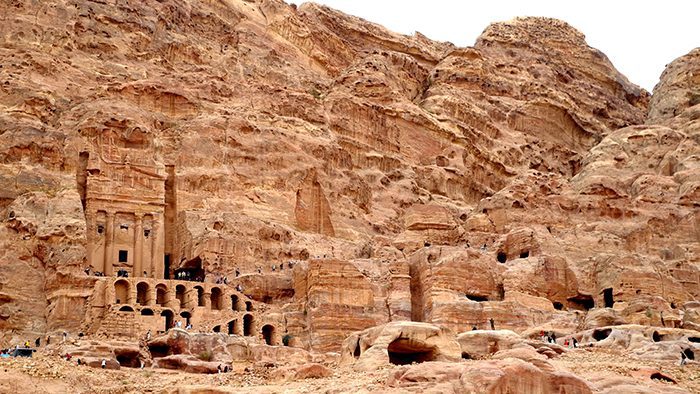
The Urn Tomb is the largest of all the royal tombs. Carved in 70 AD, the tomb features an enormous courtyard and a main chamber. Directly above the doorway are three chambers, but a stone with a drawing of a buried man blocks the central one. In the 5th century, it was consecrated as a church and underwent renovations.
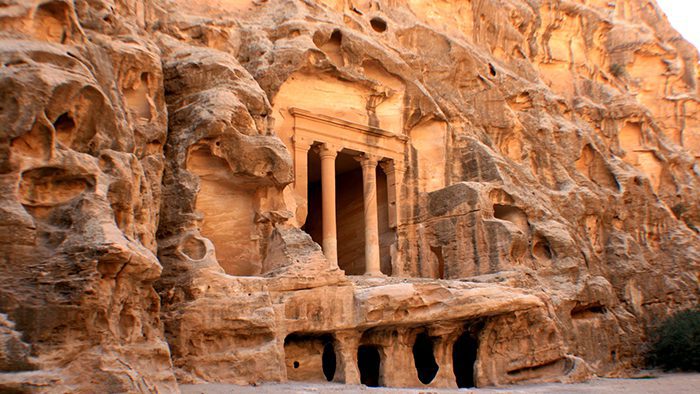
About five miles north of Petra lies Al Beidha, or Little Petra. This smaller version of grand Petra makes for a great day excursion because of its proximity to its larger counterpart. Al Beidha is believed to have been a suburb of Petra and an important place of commerce for the Nabataean people. Complete with a small Siq (known as Siq al-Barid), sandstone buildings, a water channeling system and regal tombs, Al Beidha is the perfect compliment to Petra for archaeology lovers. Entrance to Al Beidha is free.

It is easy to understand why Petra was voted one of the New Seven Wonders of the World in 2007. Entering the city is like stepping back in time to simpler era, when Bedouin tribes freely roamed and traded goods. The city itself has a rich and storied history, from succumbing to Roman forces to being the site of the legendary battle led by T. E. Lawrence. A Byzantine church, one of the remnants of the Roman occupation, contains some incredible mosaics.
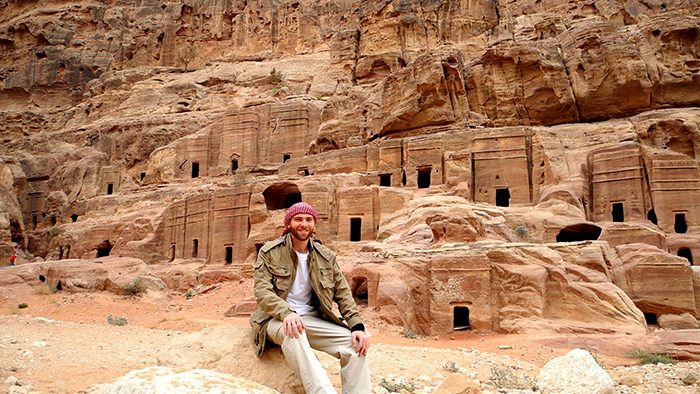
Petra simply does not compare to any other place on Earth. The full force of the city’s beauty hits you from the moment you enter the Siq. The sandstone walls that make Petra the fortress it is stretch for miles above you. Their etched patterns caused by centuries of blowing sand and winds are a sight to behold. Once inside, the incredible carved structures will leave you in awe, as will the numerous royal tombs scattered throughout the site.
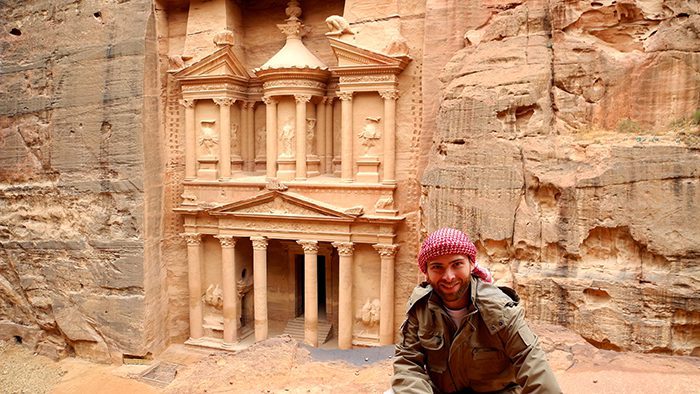
The only people that work in Petra are members of the local Bedouin tribes who have inhabited the region for centuries, and are allotted housing near the city. Because of this, Petra has lost none of its old-world splendor and it is easy to imagine what the city was like during its heyday centuries ago.
Time zone: GMT +2
Getting around: While most of Petra’s sites can be seen on foot, there are many animals available to relieve achy feet. Horse and buggy, mule and camel rides are offered throughout the park. Try walking in and seeing the main sights on foot, then getting a camel ride back to the entrance. This way, you don’t miss out on the drama of arriving at the stunning As-Siq as you enter. All rides are negotiable, but know that they are pricey. A camel ride back for two can cost anywhere from 15 to 20 JD. A horse and buggy ride from the entrance to Al-Khazneh (Treasury) is 20 JD and can be purchased at the Visitors Center.
Entrance fee: Cost of park entry for non-Jordanians is 21 JD per day. All children under 15 enter free of charge.
Hours of operation: Petra is open every day from 6 a.m. to 6 p.m.
Practical information: The Visitors Center in Wadi Musa is where you enter the park. It takes about 20 minutes to walk into the park and another half an hour to walk through the Siq. Petra has a dusty desert terrain, so wear socks and comfortable shoes that will protect your feet from the sand (walking boots or sneakers). A hat, sunscreen and a water bottle are also must-haves for your Petra experience to be as comfortable as possible. Remember to bring cash in Dinars for tipping, camel rides, souvenir shopping or any other things you may want to buy. Do not forget to get your picture taken in front the Treasury!
Shopping: Throughout Petra, there are tents from which the Bedouins peddle crafts such as hattahs (checkered head scarves), silver jewelry, key chains and glass bottles filled with multicolored desert sand. You will also find women selling handmade trinkets from blankets throughout the area. Unwanted haggling is to be expected, but a polite “no, thank you” typically does the trick.
Tips for shopping: Negotiating prices is expected, but do not expect more than a 30 percent reduction of the original price. If you see a shop owner praying, wait until he is done before asking him any questions. As a general rule, the wealthier you look, the more you will pay for any given item; so you may want to leave the fancy watch in the hotel safe. Keep a close eye on your belongings. You do not want to attract pickpockets. But my best advice: enjoy yourself!
Regarding Jordan: many businesses including banks and government offices are closed on Fridays and Saturdays. Other businesses also closed Thursday afternoons. Typical store hours are 9:30 a.m. to 1:30 p.m. and again from 3:30 to 6 p.m. Most museums are closed on Tuesdays. Early closing times are common throughout the month of Ramadan.
Currency
Jordanian Dinar, symbol “JD.”
Currency converter: XE
Best time to go: September through May
Nearest airport:
Queen Alia International Airport (AMM)
+962 06 445 2000
Visa: A two-week tourist visa can be purchased upon arrival at the airport. A single-entry visa costs 20 JDs (approximately $30). A tourist visa can be extended at any police station.
Tours: Official tour guides can be hired at the Visitors Center in Wadi Musa. Prices range from 35 to 50 JD, depending on the trail you select. To access more remote areas of the park, a guide is required.
Have you visited Petra? Did you see all the 15 things to see in Petra? Leave a comment below!
Counter
101 Countries • 1432 Cities